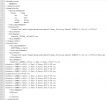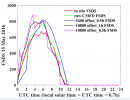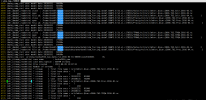Hi,
Now I can run a regional case in CLM5.0 successsfully by using the default GSWP3 datasets. I want to use my own atmforcing ( it has 1h temporal resolution, and I have processed it the standard format as GSWP3, i.e., monthly precip, solar and tphwl, meanwhile made a domain file for the atm foring) to replace, but I have met some problems:
(1) I just want to run within one month period (i.e., June 2013, because I only have this month data), but I see all of the data in 2013 (i.e., Jan-Dec) are still in need in data.streams files, how should I set up to meet the need?
(2) After some steps, I think I have replaced GSWP3 with my own foring, but the case is still running based on GSWP3 data, even I have changed the specified data path and domain path in the datm.streams.txt.
The specifical process of mine is as follows:
./create_newcase --case my_atmforc --res CLM_USRDAT --compset I2000Clm50SpGs --mach jack --run-unsupported
....
./xmlchange DATM_MODE=CLMGSWP3v1
./xmlchange DATM_CLMNCEP_YR_START=2013
./xmlchange DATM_CLMNCEP_YR_END=2013
./xmlchange STOP_OPTION=ndays
./xmlchange STOP_N=30
./xmlchange RUN_STARTDATE=2013-06-01
./xmlchange STOP_DATE=20130630
...
./case.setup
add : tintalgo = "nearest", "nearest", "nearest", "nearest", "nearest" to "user_nl_datm"
Then copy the three datm.streams.txt.CLMGSWP3v1.Precip/Solar/TPQW files in CaseDocs to the current case dirctory and revise the some routes (the datm.stream files and user_nl_clm are attached below)
Then ./preview_namelists & build & run
It can successfully run, however, the run is still based on GSWP3 data, I don't know what's wrong with it ?
Any suggestions was highly appreciated, thanks!
(the datm.stream files and user_nl_clm are attached below)
Now I can run a regional case in CLM5.0 successsfully by using the default GSWP3 datasets. I want to use my own atmforcing ( it has 1h temporal resolution, and I have processed it the standard format as GSWP3, i.e., monthly precip, solar and tphwl, meanwhile made a domain file for the atm foring) to replace, but I have met some problems:
(1) I just want to run within one month period (i.e., June 2013, because I only have this month data), but I see all of the data in 2013 (i.e., Jan-Dec) are still in need in data.streams files, how should I set up to meet the need?
(2) After some steps, I think I have replaced GSWP3 with my own foring, but the case is still running based on GSWP3 data, even I have changed the specified data path and domain path in the datm.streams.txt.
The specifical process of mine is as follows:
./create_newcase --case my_atmforc --res CLM_USRDAT --compset I2000Clm50SpGs --mach jack --run-unsupported
....
./xmlchange DATM_MODE=CLMGSWP3v1
./xmlchange DATM_CLMNCEP_YR_START=2013
./xmlchange DATM_CLMNCEP_YR_END=2013
./xmlchange STOP_OPTION=ndays
./xmlchange STOP_N=30
./xmlchange RUN_STARTDATE=2013-06-01
./xmlchange STOP_DATE=20130630
...
./case.setup
add : tintalgo = "nearest", "nearest", "nearest", "nearest", "nearest" to "user_nl_datm"
Then copy the three datm.streams.txt.CLMGSWP3v1.Precip/Solar/TPQW files in CaseDocs to the current case dirctory and revise the some routes (the datm.stream files and user_nl_clm are attached below)
Then ./preview_namelists & build & run
It can successfully run, however, the run is still based on GSWP3 data, I don't know what's wrong with it ?
Any suggestions was highly appreciated, thanks!
(the datm.stream files and user_nl_clm are attached below)





